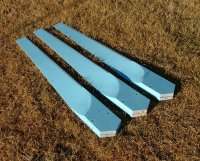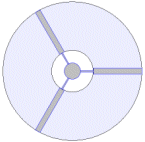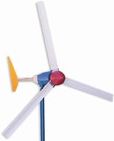 |
|
|
Site Navigation
Projects & Information
»General Information»Wind turbine Projects »The F&P Smartdrive »Electronic projects »Microcontroller projects »Miscellaneous Kits & Parts
»Basicly Natural Pty Ltd»PVC & Aluminium blades »Scale model farm windmills »Price Watch Discussion Forums
Handy Links
»Wind»Solar »Electric Vehicles »Electronics »Micro Controllers »General Interrest About TheBackShed Getting Started Privacy Policy
|
A lot of people that come to us ask us how do our blades compare to homemade wooden blades, PVC blades or even other commercial fiberglass blades. Certainly, there are costs and benefits to these different materials which are the overwhelmingly popular choices for DIYers. When it comes to matching your generator with an appropriate blade set, it pretty much boils down to the length of the blades (or swept area) and the durability. While it's great to be precise about things, when it comes to blades it's important to remember that when all is said and done, the power produced scales to the third power of the wind speed, and so wind speed will by and large be the most important variable in how much power you produce with your generator. By focusing on the "efficiency" of different blade sets, people are often missing the larger point, which is that all things being equal, long-lasting and durable blades will produce more power for you in the long-run than light-weight blades that have a marginally high "efficiency". So here we go through a few of the common materials used by DIYers building wind generators, and we give you our breakdown for why we believe so strongly in durable, weather-proof aluminum blades for home-made wind turbines. In fact, the arguments below are a very shortened version of how we arrived at manufacturing aluminum blades. PVC Blades Advantages: Low-cost, lightweight and flexible Disadvantages: PVC quickly degrades when subjected to the elements, particularly direct sunlight. We can't for a moment hide our low-opinion of blades made from Polyvinyl Chloride, or PVC. The fundamental problem boils down to the characteristics of this material. The appeal of PVC is that it's synthetic and possibly viewed as easier to work with than wood, and that's true from a time perspective since people spend substantially less time "shaping" PVC blades than they would on wooden blades. But the flip side of this equation is that since you don't shape PVC very much, you really don't get much performance out of them. Worse yet, the lack of precision in making blades from PVC and the inability of this material to withstand the elements really leads to poor performance. PVC blades will not be durable, and will simply end up in pieces when they first meet a strong gust of wind. PVC is probably the most widely used form of plastic, commonly used in insulation material as well as piping. PVC is used in many of these places because it's water-proof, flexible, and inexpensive. PVC beats out wood in durability and resilience, but you'll notice that PVC is widely used in places that don't see much sunlight--sewage pipes and wire insulation. So although PVC is far more temperature and humidity resilient than wood, these characteristics will rapidly decay after exposure to direct sunlight, which is common when, say, you expect to place your generator in direct sunlight all day every day! So what you discover is that PVC's flexibility and light weight are huge selling points, but that these very same properties will degrade very quickly in a real-world scenario. If you've ever see what happens to PVC when it sits in the sun, it becomes brittle and forms cracks. Basically, the very properties that motivated people to use PVC in the first place end up being non-existent once you put your PVC in direct sunlight. It is precisely this process which will quickly mark the beginning of the end of your blades. More precisely, the ultraviolet light from the sun will chemically degrade the PVC--plain and simple. PVC blades are inexpensive and the properties of PVC are enticing, but in practice, homemade PVC blades will have all the disadvantages of wooden blades without any of the advantages. Most alarming is that PVC blades will most definitely have a tendency to break any time an aberrant gust of wind reaches your turbine. If the test of time is one you want to pass, we confidently recommend against EVER using PVC for anything on a wind generator. Wooden Blades Advantages: Low-cost, lightweight and customizable Disadvantages: Weather- and temperature-sensitive, requires some experience and they are time-consuming to shape, limited resilience when subjected to strong winds. The home-brew, DIY movement has gained a lot of momentum in the past few years, and that is mostly thanks to one very influential DIYer named Hugh Piggott. Mr. Piggott wrote The Book that thousands of people around the world are now using to build very cost-effective and practical wind generators. He is very likely the most important voice in the DIY/homepower movement, and certainly a very prominent promoter of using wooden blades. So what's wrong with using wooden blades? Well, we would basically point out the following. When Hugh Piggott's first homebrew manuals came out many years ago, there were few companies that could offer offer low-cost, specialized components for making wind generators. So the important point to make is that those first manuals were focused on how to implement a home-brew wind power solution from widely available and easily accessible materials and methods. At that time, it definitely made sense to make blades yourself because there were few alternatives available at all that were cost-effective and available. In other words, if you lived near any place that sold wood, you could make some pretty good blades. If you are absolutely committed to building a generator with absolutely minimal up-front, direct costs, then it stands to reason that wood is the cheapest material you will find and your own labor is likely to be the cheapest labor available. For purists who want to really make a do-it-yourself turbine, wooden blades are probably the most practical material available. But using wooden blades often hides many indirect and significant costs. The disadvantages with wood boil down to two important things. Besides needing wind, your generator will only be as good as the components that go into it. Blades are a very important part of your generator, and if they aren't balanced and optimized for wind capture, you will find that you will not have an optimized wind generator. Many people are able to design very good wooden blades, which can perform very well because they are so light-weight and aerodynamic. However, many beginners will often find that they have to go through a few iterations of blades before they really manage to fashion a balanced, symmetrical and efficient blade set. Once you are shaping the perfect set of blades, they will still have a limited shelf-life. No amount of paint and no coat or varnish will change the simple fact that wood WILL expand and contract with variable temperatures and humidity (substantially more than metal will). So no amount of skill can avert the fact that your blades will warp over time and diminish the efficiency of your generator by introducing small imbalances. As you embark on your first efforts to build a generator, you will find that it's often advisable to choose components that anticipate the "worst-case scenarios." The reason is because the frequency of worst-case scenarios is stunningly high, especially when you realize how unpredictable the weather and wind are. You will find that although your wind speed might average 10 mph in your area, the average doesn't tell you much about the frequency of severe weather and the few days a year where the odd storm blows through with "unusually" strong winds. Certainly, a crazy gust of wind that happens for as few as 10 minutes on 5 different days a year sounds like a really rare event. But if you lack a sophisticated furler and other protective mechanisms, then you'll find that those few minutes out of the whole year are what end up costing you the most, because what you end up with are shards of wooden blades strewn across your property. (There is another issue at play here. One is that furling also protects the generator from overheating and frying/melting your stator coil. So, even though your aluminum blades will survive the high winds, you will still overheat your generator.) And if that happens 5 times a year, that's a substantial amount of downtime. Our philosophy at WindyNation is that a good and efficient generator isn't the one that has the lightest blades or even the ones that spin the fastest. One of the most important qualities of your generator is simply that it has staying power and minimum maintenance and replacement costs. Downtime and the cost of replacing components often go hand-in-hand, and for many generators the single biggest cost doesn't necessarily come from a single component, it comes from all the time your generator is on the ground because of broken components, which for many people ends up being the blades. With some basic assumptions about how much time is lost from having a downed generator, how much it costs you in replacement materials, how much in human labor you need to invest in preparing a new blade set, then you can very quickly calculate that many people are costing themselves as much as $300 per year dealing with replacing blades due to breaks, cracks or poor performance. |
||||||||




